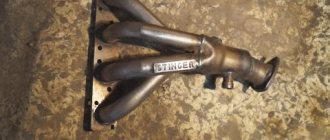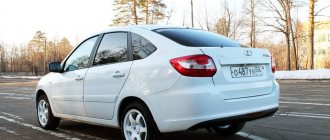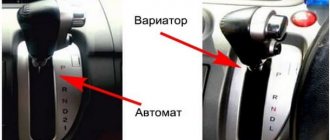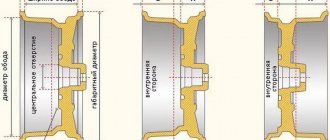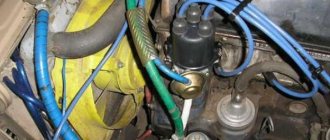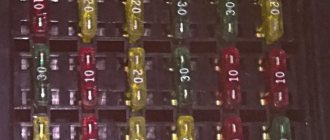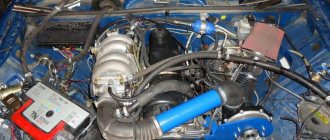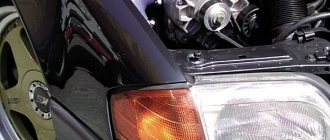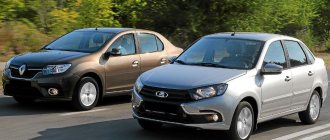Turbocharging and compressor - differences
Turbocharging and compressor - differences
The main difference between a turbine and a compressor is the operating principle. The turbine is driven by the exhaust gases, while the compressor is spun by the engine itself, which is why it is also called a mechanical supercharger. The advantages and disadvantages of the two devices installed in order to increase the performance of the power unit are associated with the operating features.
A compressor that is simpler in design is most often rotated by a belt drive from an engine. The most common centrifugal superchargers use an impeller to force air through its housing and send it through the intake manifold into the cylinders, which adds power to the engine. The main advantage of this type of supercharger is its constant operation, regardless of engine speed. In addition, among the advantages are unpretentiousness of operation, lower cost compared to a turbine, relative ease of installation and a wide range to choose from.
The disadvantages include limited power and a lower percentage of efficiency while increasing fuel consumption, since the engine will spend additional energy to drive the compressor. rnrnA more complex turbocharger consists of two impellers. The first impeller rotates due to exhaust gases and through the shaft ensures the movement of the second, which sucks in air. The main advantage of this device is that it has a high percentage of efficiency and allows you to significantly increase the power of the power unit, while its fuel consumption remains unchanged.
The most important drawback is the presence of the so-called turbo lag or turbo lag, in which the operation of the turbine is not felt at low speeds. This is due to the fact that the low flow of exhaust gases is not able to sufficiently spin the impeller, and therefore air is either not sucked in or is sucked in insufficient volume. The high cost and complexity of the design can also be attributed to the disadvantages of turbochargers. This article was published in the MOTOR public page. If you see this article in another community, it means lazy administrators of other communities are blatantly copying the material from us and don’t even read it. Features of turbine designs also include the need to use high-quality oil, constantly monitor its level and timely replacement. After work, especially for a long time or at high speeds, a turbocharged engine requires a minute's rest at idle speed.
Currently, automakers have learned to combine compressors and turbines in one engine, where their symbiosis allows you to get rid of the effect of turbo lag.
In addition, to combat this disadvantage, two or more turbines of different sizes can be used (small ones operate at low speeds, and large ones at high speeds) and turbines with variable geometry.
collected from social networks
I am collecting the material for myself, please do not criticize
Source
Description of technology
The technology of supercharging and compressors appeared back in the 60s of the last century, but it did not gain the popularity it deserves. This is explained, first of all, by the poor reliability of these components, as well as problems with the operation of car engines. The turbines, in fact, were inactive until medium engine speeds; accordingly, at low speeds there was a significant lack of power, which complicated the operation of the car. And subsequently, as soon as the turbine was turned on, the engine received additional power, which an inexperienced driver was simply unable to cope with.
Compressors were initially used primarily on British cars, increasing the already powerful 8-cylinder engines, which developed 500 horsepower or more. The motor with such a compressor did not have compact dimensions, which made it difficult to install in the engine compartment, and subsequently made servicing the car much more difficult. Most workshops simply did not undertake to repair the car. Therefore, any breakdown became a headache for the car owner, and the car spent months in a garage or service center.
Compressor differences
A compressor is a mechanical supercharger installed directly next to the engine. It can use screw, rotary or centrifugal operating principle. Such designs became widespread in the 60s and 70s, being installed on British and American cars. Today, such superchargers are often used on Mercedes, Jaguar, Bentley, Audi and others.
The main advantage of the compressor is its constant operation, that is, the engine receives power throughout the entire speed range, which eliminates any failures when accelerating the car. Today, the design of such compressors has been significantly improved, which has increased their reliability and simplified maintenance of attachments.
Thanks to the simple design, it is possible to additionally install compressors on already used atmospheric units. This type of tuning is not complicated and is very popular among car owners who would like to increase the power of their car. You can choose mechanical compressors of various types and models, which are designed for both large-volume engines and small units with a volume of 1.5-1.8 liters.
Advantages and disadvantages
Engines equipped with mechanical compressors have the following advantages:
1. minimal risk of overheating;
2. the compressor does not require additional lubrication and cooling;
3. there is no turbo lag;
4. Simple design is reliable and durable.
The only disadvantage of compressors is their low performance. Standard models can increase motor efficiency by only 10-15%. Only by installing a powerful centrifugal compressor can it be possible to increase engine power by 40-50%. In this regard, the compressor is much worse than conventional turbines, which are capable of increasing the efficiency of the engine by 2-3 times, providing power of 200-300 horsepower even with a small displacement.
A little theory
First, it’s worth understanding exactly how the power of the power unit is increased. First, a trivial description of how an internal combustion engine functions: it runs on an air-fuel mixture, which ignites and burns in the cylinders, providing the engine with the necessary energy to operate. The mixture consists of two components - air and fuel (diesel or gasoline).
For efficient combustion of the fuel-air mixture in the cylinders, a certain amount of fuel and a certain amount of air are required. And if there are no particular problems with supplying more fuel, then driving more air into the cylinder is no longer so easy.
To solve this problem, a turbine or compressor can be used, which we consider in this article. And although both of these devices force air into the engine, they work on completely different principles.
Ways to increase engine power
Before we look at the difference between a supercharger and a turbo and see which technology is better, it makes sense to familiarize yourself with the principles used to make modern powertrains more powerful.
The operation scheme of any internal combustion engine is quite simple: the driving force is the fuel, or rather, a mixture of air and fuel, which burns in the cylinders, forcing them to perform reciprocating motion. Both components are supplied to the engine separately. Fuel (for specifics, let's take gasoline) is supplied to the intake manifold through a fuel line, and its supply is provided by a separate pump. The air enters the engine by gravity, being cleaned through an air filter. If it becomes clogged, the power of the power unit drops, increasing consumption.
But if you use devices that provide an unhindered supply of increased volumes of air, and even under pressure, you can partially solve the problem of increasing engine power without the need to increase the volume of the combustion chamber. The amount of oxygen increases, which means that with simple adjustments you can achieve an increase in the supply of gasoline, as a result of which the engine efficiency increases.
The compressor and turbine precisely perform the task of pumping air into the cylinders, and to this day remain the most affordable and easily implemented devices for increasing the throttle response of an internal combustion engine with the same dimensions. Of course, there is still an increase in size - at least due to the presence of the additional devices themselves, but in proportional terms this is not comparable with the need to increase the volume of the working cylinders, since this will lead to the need to change the dimensions of the engine itself, including its housing as the most massive component of the entire car .
Well, now let’s look at the operating features of both types of devices.
Compressor
This is a mechanical type air injection device, it appeared before turbines, but is still used by both car manufacturers and tuning car repair shops. The compressor is mounted, one might say, “next to the motor” and does not directly interfere with its design.
There are three types of compressors: centrifugal, rotary and screw. The main difference between them is the way the air is compressed and how it is supplied to the engine intake.
The operating principle of a centrifugal, rotary and screw compressor
A centrifugal compressor is an impeller that rotates at high speed and forces air into the compressor housing. The rotation speed can reach 50-60 thousand revolutions per minute. In this case, the air that enters the central part of the impeller is shifted to its edge under the influence of centrifugal force. As a result, air leaves the impeller at high speed but at low pressure. Next, to increase air pressure, a diffuser is used, which consists of blades located around the impeller. These blades convert fast air flow with low pressure into slow air flow with high pressure. This type of compressor is the most common and most efficient.
Main function
Mechanical superchargers-compressors and turbines have the same function - increasing engine power. This is achieved by forcing air into the cylinders under high pressure, which ensures simultaneous excellent vehicle dynamics and fuel efficiency. Engines equipped with compressors and turbines significantly increase productivity, improve dynamics, and there is no need to install multi-liter engines; a 2-liter unit is enough, which will produce 250 horsepower.
The main differences between turbines and compressors are only in their operating principle. The turbine blades are installed at the outlet, and as soon as the engine starts and runs at minimum speed, the boost is inactive; only after 3000 engine revolutions does the supercharger begin to spin up, which significantly increases engine power. But the mechanical supercharger compressor has a chain drive from the crankshaft, so it works immediately as soon as the engine starts, which eliminates the occurrence of so-called turbo lag.
Turbine
Turbine operating principle
Unlike a compressor, a turbine is “built” into the engine, uses its oil and operates from exhaust gases, that is, it “interferes” with the exhaust system.
The principle of operation of the turbine is as follows: gases enter the engine exhaust, then go to the hot turbine wheel (spinning it), the rotational energy is transferred to the cold wheel, which begins to rotate quickly and pump air into the engine intake.
Turbine advantages:
Disadvantages of the turbine:
In fact, the main and only advantage of the turbine is the impressive increase in engine power; then there are only disadvantages.
Technical differences between a centrifugal supercharger and a turbine
A centrifugal supercharger is very similar to a turbocharger if you look at it from the side of such a technical element as the compressor diffuser. In common parlance it is called a “snail” for its similar appearance, and this is no coincidence.
Like a turbine, it uses an impeller to compress air coming from outside and force it into the engine cylinders. The main design difference, as you might have guessed, is the elimination of the use of exhaust gases to spin the impeller - the centrifugal supercharger instead uses a pulley driven mechanically by the engine. Therefore, it belongs to the type of driven superchargers.
What is better, a turbine or a compressor?
In fact, it all depends on what kind of effect the car owner needs, and this is always strictly individual. The following conclusions can be drawn.
Turbine. Gives a huge increase in engine power, up to 40%. Relevant for rally races or for fans of street racing. True, you will have to spend a lot of money both on the purchase of the device itself and on its installation, configuration and maintenance. Plus you have to put up with high oil consumption, lag and frequent repairs.
Compressor . Suitable for drivers who do not need such an impressive increase in engine power. At the same time, the car owner does not want to have problems with servicing the equipment, since the compressor is used according to the “install, configure and forget” principle - its service life is enough for the entire period of using the car. And the cost of the device itself is several times lower.
Source
turbine VS compressor... Which side are you on?!
While working with one interesting machine, I asked myself the question: “What distinguishes a compressor from a turbine, or vice versa?! As you know, rearranging the terms does not change the sum...”
Having sailed a little through the expanses of the Internet ocean, I came to the following...:
Turbine
– a rotary engine, the peculiarity of which is continuous operation. The rotor converts the kinetic energy of steam, gas or water into mechanical energy. Today, turbines are actively used as the main element of the drive of a wide variety of vehicles (land, sea and air). No matter how incredible it may seem, an attempt to create a mechanism similar to a modern turbine was made before our era. And only at the end of the 19th century, with the development of thermodynamics and mechanical engineering, steam turbines began to appear, characterized primarily by high functionality.
A compressor
, in turn, can be different and used in a wide variety of industries. It is necessary for compressing and supplying gases (including air) under pressure. This device was invented in order to significantly increase the maximum engine power, because more air is pumped into the combustion chamber. As a result, more fuel enters the cylinder, which in turn means that the final goal has been achieved. For clarity, here are some numbers: on average, a compressor can add about 46 percent of power (plus 31 percent of torque). Now these devices are actively used to increase engine power in both cars and trucks. Today, compressors are the most optimal and economical option for those who want to increase engine power and add a certain amount of horsepower to it.
Comparison of turbine and compressor
And so, to summarize, the difference between a compressor and a turbine is as follows:
= The compressor ensures proper operation of the engine (uninterrupted combustion of impurities). = The turbine has no effect on horsepower loss (total power output of the power unit). = The degree of complexity of installing and configuring the device. In this regard, the compressor has an advantage. = The turbine requires an oil supply, which affects the entire operation of the car. = The turbine will have to be constantly maintained and diagnosed. = The turbine is installed directly into the engine, and the compressor is a separate device. = The compressor has a fixed power, and the operation of the turbine depends on the speed of the car. = A turbine is capable of accelerating a car at a higher speed than a compressor. = The compressor consumes more fuel with lower efficiency than the turbine. = The compressor can be selected for any car model, but the turbine has a small selection. = The cost of the turbine itself and its installation is higher than the price of the compressor.
Scope of application and operating features
What is better, a turbine or a compressor? For a complete answer, let's look at both devices in parts.
Structurally, a turbine is an engine that is constantly in motion by converting the energy of liquid or steam into mechanical energy. It must be said right away that the drive mechanisms for both are completely different.
The compressor is powered by the engine crankshaft and has an autonomous unit, while the turbine receives gases from the exhaust manifold and has no autonomy.
The difference in price is noticeable:
for a good quality turbine, pay about 550 bucks, and a compressor only 200, and the power percentage is the same, from 15 to 25% maximum. Additionally, there will be costs associated with installing and setting up the unit in a car service center.
Which is better: a turbine or a mechanical compressor?
Many car enthusiasts often wonder which solution will ultimately be the best - a turbine or a compressor? This question may arise both when choosing a new car and when buying a used car. Tuning enthusiasts are no less often faced with the task of making such a choice.
It is worth noting at the very beginning that both devices simultaneously have a number of specific advantages and disadvantages. All this clearly influences the final choice. The differences between these systems lie not only in appearance, shape, weight, method of mounting on the engine and dimensions, but also in the main principles of operation. It is not always easy to clearly identify all the main criteria when choosing a particular device. Let's look at this issue in more detail.
Mechanical supercharger and turbocharger
The turbine is a rotary engine, the peculiarity of which is its constant and continuous operation. Early attempts to create a turbine were made at the dawn of human development, but high-quality implementation became possible only in the 19th century. The era of mechanical engineering development made it possible to create the first turbines, which were steam. The turbine converts the kinetic energy of steam, gases or water into useful mechanical work. Turbines have found their application in many devices and have also become an integral part of various types of transport. This applies to both land vehicles and sea vessels along with aircraft.
If we talk about the compressor, the design of the device can have different modifications and is successfully used in many industrial fields. Its main task is to compress and supply gas under pressure.
Further development of technology led to the emergence of a kind of symbiosis of turbine and compressor. The development of a turbocharger has significantly increased the efficiency and power of engines.
As you know, you can get maximum engine power without increasing its volume by forcing more air into the combustion chamber. All that remains is to supply more fuel and the power of the power unit will increase significantly. As data given in various sources show, on average, a compressor provides an increase in power of up to 50% and provides about a 30% increase in torque.
Both a fully mechanical and a turbocharger can successfully cope with this task separately. But which of these solutions is better? Let's compare a mechanical compressor and a turbocharger.
Here's How Centrifugal Driven Superchargers Work
Externally, centrifugal superchargers look very similar to their closest relatives - conventional turbines. Indeed, there is much in common between the two systems for supplying air to the cylinders, but nevertheless they have no less differences.
Using forced induction to produce more power per unit engine displacement can be achieved in several different ways. One such method is to use a centrifugal supercharger, which uses the engine's mechanical power rather than exhaust energy to force more air into the cylinders, burn more fuel and produce more power. But how exactly does a centrifugal supercharger work? A little educational information below.
What happens in the end
As you have already understood from the above, installing any type of compressor is not the easiest task. Before installation, it is worth carefully weighing the pros and cons of each of the available supercharging solutions, as well as calculating the necessary final power indicators in accordance with the task at hand.
Today, the optimal system can be considered a dual supercharging system, when a mechanical compressor and turbocharging are used simultaneously on one engine. At the same time, the devices operate at different speeds, providing maximum elasticity and comfort over a wide range of engine speeds.
Source
